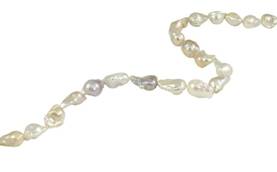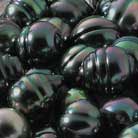 |
 |
| Because Cultured Pearls are organic gemstones formed by nature no two pearls are exactly alike. A variety of factors go into determining the quality and price of pearl jewelry. There are 6 factors which determine the value of a pearl and, they apply equally to Akoya, South Sea, Tahitian and Freshwater pearls. |

|
The most important factor is luster, which is light reflected from the pearls surface. When you look at a group of pearl strands or loose pearls, your eye is naturally drawn to the one with the highest luster. For cultured pearl experts, luster is perhaps the most important indicator in evaluating cultured pearl quality. Luster is what separates the inferior pearl from the superior and the ordinary from the extraordinary. Luster is what many experts term the heart and soul of the sea-grown gem. Throughout history, this unique luster has separated pearls from all other gem.
For the layman and jewelry novice, the luster of a pearl can best be described as a combination of a high, reflective sheen on the surface of a pearl combined with an almost three-dimensional glow that seems to emanate from within the heart of a pearl. For the average person, evaluating the luster of a cultured pearl is not rocket science. Luster can be judged easily by the naked eye and without any equipment. Pearls with high luster have the ability to sharply reflect images around them, almost like a mirror. In addition they always display the characteristic depth or three-dimensional glow and a subtle display of different surface colors (sometimes referred to as orient) that is so prized among high-quality pearls. Pearls with low luster often look dull, monotonous, chalky and lifeless. |
 |
The next factor is nacre coating. Nacre coating can affect luster and can also affect the durability of the pearl. A pearl with thin nacre coating can have nice luster, but one with a thicker coating will have better luster. Nacre coating in Akoya pearls is usually one-half to one MM in thickness. In South Sea and Tahitian pearls it can range from .8 to 4MM in thickness.
Freshwater pearls that are nucleated with only a mantle piece are composed entirely of nacre because during the cultivation period the mantle piece disintegrates leaving only nacre.
SURFACE IMPERFECTIONS

there are 2 pearls of equal quality the one with the fewest imperfections on the surface will be more valuable |
Here are examples of a range of cultured pearl surface quality. The pearl at left has a damaging pinhole. Beside it is a pearl with a damaging chip and crack. Next are non-damaging bumps and pits, then non-damaging wrinkles and finally a blemish-free pearl.
Surface imperfections are the next factor. If there are 2 pearls of equal quality the one with the fewest imperfections on the surface will be more valuable. Wavy or rough surface skin will also decrease the value of a pearl. Think of good-quality pearls and you’ll likely think of smooth surfaces. In fact, surface is the second most important aspect in evaluating a cultured pearl after luster. Surface quality refers specifically to the abundance or absence of physical blemishes or flaws. When evaluating surface (the trade uses such terms as blemish, spotting and cleanliness), remember that cultured pearls are grown by live oysters in nature. As such, there are many uncontrollable forces that affect the surface. |
Shape
Round Pearls are worth the most

Shape is the next determining factor. All things being equal, the rounder the pearl the more valuable. Other shapes are baroque which is very irregular, drop shape, button shape and oval
shape. The pearl with the most luster and fewest surface imperfections in any shape will be the most valuable. |
Shape
This is a category where you could drive yourself crazy. I might look at a pearl and say it looks oval shape. You might look at the same pearl and say it looks more barrel shape. Who is correct? For the sake of simplicity we will designate 3 categories for shape. They will be Round, Semi or Off –Round and Baroque.
Round
Round is the most recognizable and sought after shape. When the Japanese select pearls for shape, they let the pearls roll down a large inclined piece of glass. Some pearls veer off to the right or left and some roll straight down. The ones that come straight down are round.
Semi or Of f-Round
The Semi or Off-Round category encompasses a wide variety of shapes. It includes pearls that are so slightly out of round that it is very difficult for the untrained eye to notice that they aren’t perfectly round to pearls that are button shape, drop shape, coin shape etc. Pearls in this category are uniform and proportioned in their shape as opposed to irregular in shape which leads us to the last category.
Baroque

Baroque pearls are irregular in shape. There are 2 classes of Baroque pearls, baroque and semi-baroque. To give an example, you might consider a pearl in the shape of a stone to be semi-baroque while one with a nacre build up on it that looks like a tail on the pearl would be considered baroque. Here again you can have different opinions on what passes as baroque and semi-baroque.

Some ware between shape and surface are ringed or circled pearls Ringed or Circled pearls are characterized by regular streaks or concave rings perpendicular to an axis of revolution over more than the upper third of the pearl’s surface. All things being equal, a round pearl will be more valuable that an off-round
or semi-round pearl and both of these will be more valuable than a baroque or semi-baroque pearl. If however all things are not equal a round pearl is not always the most valuable. For example, one pearl can be very round, thin coated with low luster. Another pearl can be slightly off-round, having heavy nacre coating and high luster. Even though this pearl isn’t round it is worth more than the round pearl because of its thick coating and high luster.
European countries prefer off-round, heavily coated, high luster pearls with spotting to the thin coated lower luster clean round pearls that are popular in America. There are a lot more of this type pearl cultivated than there are round pearls. So, you are paying a premium for pearls that are round but might not be as good a quality as others that aren’t round. Things like this are what make cultured pearls such an interesting industry.
|
COLOR

COLORS OF FRESHWATER

TAHITIAN COLOR

SOUTH SEA COLOR
South Sea
Color is the next factor. Color is a matter of personal taste. In the US when referring to Akoya and South Sea pearls white rose` and silver rose` are the most popular. In South America creamy or golden color is the most popular. Tahitian pearls are naturally black or gray. You may prefer a peacock color (a rainbow effect of different shades of black or gray) while I prefer an aubergene (reddish black ) color. Remember that your personal preference in color might not be the same as your customers.
|
SIZE

|
Size is the last factor. If you have two pearls that are equal in luster, nacre, surface imperfections shape and color, the larger one will be more valuable. There can be exceptions and the exceptions are for pearls that are unusually large for a pearl type. For example: a 10MM South Sea pearl is not considered large or rare but, a 10 MM Akoya pearl is. In this case, if both pearls were of similar quality, the Akoya pearl would be more valuable than the South Sea pearl.
|
Matching
For pearl necklaces the overall look is very important, regardless of the quality of the individual pearls. The more uniform and aesthetically pleasing two or more pearls look together the more time was spent matching the pearls. This time to match pearls is reflected in the cost. |
|
|
|
|
